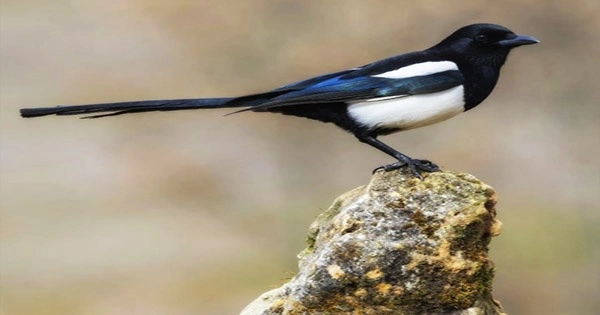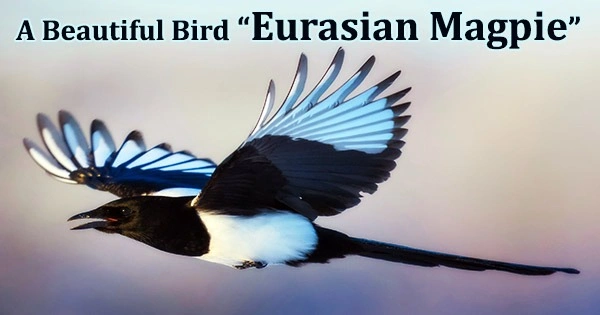The common magpie (Pica pica), sometimes known as the Eurasian magpie, is distinguished by its wings that are streaked with purple, green, and blue colors. It is a permanent breeding bird that can be found all over northern Eurasia. The belly and scapulars (shoulder feathers) are both completely white, while the body is a glossy black color with a metallic green and violet shine. An old British rhyme predicts a person’s fate on the basis of the number of magpies they’ve seen: “One for sorrow, two for mirth, three for a funeral, and four for birth.” Some say that if you fail to salute a magpie you’ve walked past, bad luck waits patiently behind the next corner. A solitary magpie, whose species mates for life, perched on a window of your home is an omen of loneliness and impending death, according to popular belief. Although the name of the impoverished bird carries a lot of mythological connotations, the magpie’s greatest marvel derives from its innate talent. In Europe, “magpie” is used by English speakers as a synonym for the Eurasian magpie: the only other magpie in Europe is the Iberian magpie (Cyanopica cooki), which is limited to the Iberian Peninsula. In Asia, these elegant birds are even considered to bring good luck and in Native American cultures they are spirit beings connected to humans. One of the smartest birds and possibly one of the smartest creatures other than people is the Eurasian magpie. In terms of proportional size, the expansion of its nidopallium is comparable to the brains of chimpanzees, gorillas, orangutans, and humans. Only one bird and a very small number of other non-avian creatures have been known to pass the mirror test. The common magpie is among the most intelligent birds and mammals ever to have lived. Their brain-to-body mass ratio is equal to that of big apes and aquatic mammals, and it is only surpassed by humans. With its distinctive black and white plumage, metallic blue markings, and long, dark, shining green tail, the Eurasian magpie is easy to identify. The Eurasian magpie cannot be mistaken for any other bird, even by the untrained eye, which makes these corvids an excellent starting point for bird watching. Male and female magpies unfortunately are not visually distinguishable.

Magpies have demonstrated the capacity to create and utilize tools, mimic human speech, express grief, play games, and collaborate in groups. When a member of their own species passes away, a crowd will gather around the body for a “funeral” of cries and squawks. Magpies will utilize home-made utensils to cut foods into the right sizes to distribute out to their young. The range of Eurasian magpies extends across temperate Eurasia from Spain and Ireland in the west to the Kamchatka Peninsula. Although populations living close to the northern border of their range in Sweden, Finland, and Russia can travel south in severe weather, these birds are typically stationary and spend the winter close to their nesting areas. Eurasian magpies typically stay away from treeless areas and heavily forested areas and prefer to reside in open countryside with sporadic trees. They frequently reside close to urban centers and may reproduce in suburban areas like parks and gardens. The adult male of the nominate subspecies, P. p. pica, is 44–46 cm (17–18 in) in length, of which more than half is the tail. The wingspan is 52–62 cm (20–24 in). The wings are black with green or purple gloss, and the primaries contain white inner webs, which are noticeable when the wing is open. The head, neck, and breast are glossy black with a metallic green and violet sheen; the belly and scapulars (shoulder feathers) are pure white. The graduated tail is black with glossy reddish-purple and green accents. The legs and bill are black; the iris is dark brown. The plumage of the sexes is similar but females are slightly smaller. The tail feathers of both sexes are quite long, about 12–28 cm long. Males of the nominate subspecies weigh 210–272 g (7.4–9.6 oz) while females weigh 182–214 g (6.4–7.5 oz). Eurasian magpies typically occupy the same region for several years and live in mated pairs. They frequently congregate in loud groups outside of the breeding season, flying around and even putting on varied performances. These birds are active during the day and spend the most of their time on the ground looking for food. Additionally, they might take food from other birds or stow it away in the groundhole for later use. Eurasian magpies have a well-known call. It is a choking chatter “chac-chac” or a repetitive “chac-chac-chac-chac”. Young birds also emit the previous call, although they also emit an acute call similar to a “Uik Uik”, which may resemble the barking of a small dog. The Eurasian magpie usually lays between 4 and 7 eggs in a nest made of twigs and roots, padded with leaves, grasses or clay. The eggs themselves are up to 3.4 cm in size and have a pale green base colour covered with darker, olive-green to brown speckles. Young and old can both make a kind of hiss that is hardly audible up close. Magpies from Asia are omnivorous birds. They eat eggs, young birds, small mammals, insects, carrion, acorns, grain, and other plant matter. Magpies are also capable of passing a cognitive experiment called the “mirror test,” which proves an organism’s ability to recognize itself in a reflection. In order to conduct this test, a colored dot is applied to either humans or animals in a location that can only be seen by looking into a mirror. Subjects succeed if they can distinguish the mark in their own mirror as being on them and not someone else, frequently by reaching out to touch or remove it. Only four other animal species are capable of passing the mirror test, demonstrating their high level of intellect.
















